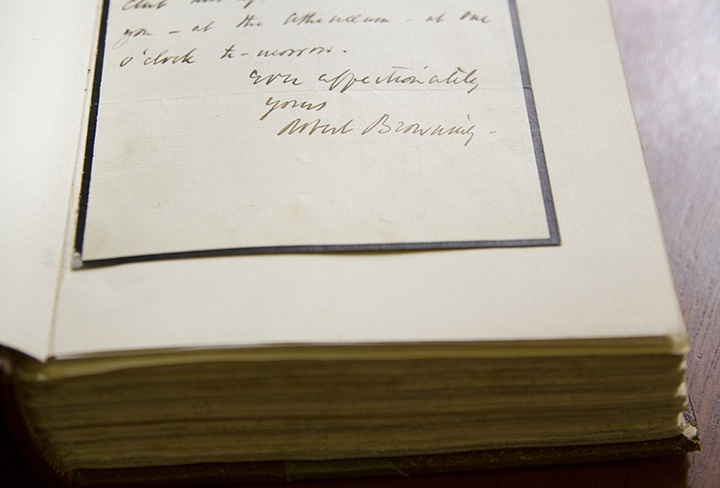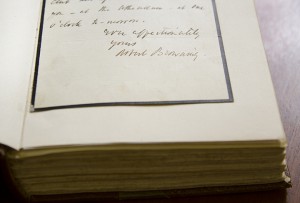

(Ashley Pereyra | Reporter)
By Ashley Pereyra
Reporter
The study of Robert E. Browning, English poet and playwright, just got a little more contemporary.
Melinda Creech, a graduate assistant at the Armstrong Browning Library, has uncovered a connection in the library’s online digital archives between Browning and Highclere Castle, the set of the hit PBS show “Downton Abbey” — a British period drama which focuses on the fictional, aristocratic Crawley family in the early 20th century.
Before the start of the third season of Downton Abbey on Jan. 6, PBS aired a historical piece on the show, called “Secrets of Highclere Castle.” Creech, like many “Downton Abbey” fans, watched the piece to learn about the real history behind the show.
“They were telling the real story about Downton Abbey,” Creech said. “The real castle, the real lords and everything. They mentioned that the lord’s name was Lord Carnarvon.”
Carnarvon was a name that Creech recognized from her efforts to process and digitize letters for the library. Using her laptop that she stores her transcriptions on, Creech did a search for the lord. The letter that came up initially had no connection to Browning. But after doing a search on Baylor’s online database called The Brownings: A Research Guide, she found 26 letters between Lord Carnarvon and Browning.
“And then I watched the show and I thought, ‘Oh my goodness. Browning was sitting in that library. He was walking on those grounds. And he was smoking in the smoking room with people. He maybe ate dinner at that table,’” Creech said. “So it made it all the more interesting to think he was actually in that place.”
However, Creech’s search did not end with a few clicks on a keyboard. She contacted the archivist at the Highclere Castle to inquire if there were any books or photographs in the library of Browning.
There were none.
“But what I did find out from him is that they have two letters that we don’t think we were aware of,” Creech said. “We are checking now into what the content of the letters and the dates of the letters to make sure. So those will be two letters that may be added to our knowledge about Browning letters.”
Creech also said there may be other castles in England that have letters to and from Robert and Elizabeth Browning that they don’t know about right now.
“It’s always amazing to me that there are still letters and manuscripts of the Brownings that keep appearing.” said Rita S. Patteson, director and curator of manuscripts at Armstrong Browning Library. “Most of the time they come out of private collections. Maybe it has passed down several generations of the family and now that they have come to spot where they are not that close to the Browning, they not that interested. And they would rather have the money. So they put it up for auction.”
Creech, at the initial request of Patteson, said she has written about her discoveries on the Armstrong Browning Library blog. So far she has, through her research, uncovered instances where Robert Browning was actually at Highclere Castle. For example, Browning was at a shooting party at the castle, according to a letter to his sister on Dec. 1, 1869. This would have been around the time that the father of George Edward Stanhope Molyneux Herbert, the fifth Earl of Carnarvon, the historical counterpart to Robert Crawley, Earl of Grantham, was in control of the castle.
Creech said this was particularly interesting because of the writing of a book “prequel” by Julian Fellowes, the creator and writer of the show. The prequel would be set during the time that Robert Crawley’s father would be alive, according to BBC news. This would make Browning a potential character for the drama. Creech wrote to PBS in light of this discovery.
Amid the news that Fellowes may leave the show for his new show, “The Gilded Age,” an American period drama set in New York City during the 1880s, the future of a “Downton Abbey” prequel is uncertain.
In a New York Times article on Feb. 18, Fellowes said if “The Gilded Age” is given the green light at NBC and “Downton Abbey” continues after the fourth season, he cannot write both shows at once and most likely will leave Downton Abbey. Therefore a prequel in the near future is not a likely scenario.
The ease at which Creech was able to make these discoveries is on part of a worldwide effort to digitize all Browning letters Patteson said.
The Armstrong Browning Library houses the biggest collection of Browning letters in the world, totaling nearly 2,800 letters. The overall total of Browning letters is currently 11,567. The library offers in-house access to the Browning database that provides access to all the letters.
“The library has become more technologically savvy,” Patteson said. “We’re still not quite there, but we have a lot more items digitized and information available on the website.”
For more information or to read the blog, visit https://www.browninglibrary.org/.





